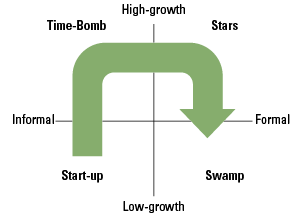KPMG held interviews at 30 successful scale-ups in the Netherlands about their path to success. We then used data analysis to investigate the role of the internal organization. What is the effect of formalizing and implementing management control systems?
‘Management control systems are formal, information-based routines and procedures managers use to maintain or alter patterns in organizational activities.” ([Simo06])
Introduction
It seems that scale-ups with their steep growth curve and innovative business ideas are taking over the world. Entrenched corporates are increasingly challenged by these companies, which are able to quickly gain market share and even disrupt whole industries. However, high growth is accompanied with unforgiving growing pains and there are only a few start-ups that manage to get through the scale-up phase unharmed. KPMG performed research into scale-ups in the Netherlands to gain a better understanding of the important aspects to overcome these growing pains. We found that the expanding internal organization (including support functions) is a key feature in managing high-growth. Quantitative research even indicated that the successful scale-ups have all implemented management control systems and this implementation was already done early in a scale-ups life-cycle. Furthermore, these systems were often implemented pro-actively which enables scale-ups to reach a higher potential growth rate and prevent crises of leadership (moments of crises). Management control systems are perceived necessary for future growth and some specific systems are even perceived to drive future growth within the scale-ups. There are some important differences in the way scale-ups organize their internal organization compared to the traditional growth path. Contrary to most corporates, these high growth firms try to keep a focus on their core business as much as possible and often skip the phase of specifying departmental and organization processes. By doing this they often outsource activities to an external partner, automate processes and make use of Robot Process Automation (RPA) technologies.
What more can we learn? And how does this relate to KPMG’s known better practices?
Characteristics of successful scale-ups
Successful scale-ups overcome their growing pains and manage growth rates of over 20%
After the big boom of start-ups and start-up initiatives, policy makers are coming to terms with the fact that it is not the quantity, but the quality of start-ups that matters. Namely, the companies that survive the start-up phase and achieve great growth rates are the ones that add the most value to the economy in terms of job offers and business innovations. These companies are called scale-ups. While they can be of different ages, locations or sectors, scale-ups all have one thing in common; they managed to attain an annual growth rate of 20% for a minimum of 3 years with at least 10 FTE as basis and are commonly driven by high ambitions and innovative business ideas. Due to this high growth they quickly gain market share or even disrupt whole industries, challenging entrenched firms to improve competition and innovation. Well-known Dutch examples are companies like Adyen, Helloprint or Takeaway.
However, high growth comes with a price. Many high-growth firms experience growth pain when they are unable to adapt their internal organization structure to their new size and exponential growth. Even more, due to the world becoming more and more dynamic, we found that scale-ups experience growth pain at a much earlier stage then studies from 2010 show. That is why in the Netherlands, only around 3000 companies can call themselves scale-ups. So, what makes these scale-ups successful and enables them to overcome growth pain?
KPMG research into 30 scale-ups shows the importance of formalizing internal structures
After interviewing the scale-ups, we found that start-ups that have grown to the scale-up phase are only able to manage their growth due to formal internal structures and more specifically, through management information systems. In the first phase, the start-up organizations mainly consist of a founding team where operations are overseeable, internal agreements are informal and the entrepreneurial and creative spirit is high. When an idea gathers momentum, growth rates start to rise, and the founding team expands with more and more employees. Many start-ups hold on to their initial informal atmosphere as they believe this cultivated their creativity and their success, unaware that they moved from the start-up phase to the time-bomb phase. It is during this phase that many start-ups fail or stop growing as their high-growth rates become uncontrollable due to their initial informal structure. One entrepreneur said that up until 15 FTE he could manage the firm at the lunch-table and keep track of everything, but when they kept on growing he lost his overview and felt the need to implement formal structures, in spite of the feeling that this would lower some of the initial entrepreneurial spirit. The transition to a more formal structure enables start-ups to become a more stable and sustainable high-growth scale-up, which leads them into the Stars phase.
Scale-ups start their formalization process at a small size and early age
The 30 successful scale-ups which were interviewed already started formalizing their internal structure when they had between 4 to 20 employees. The transition from an informal to a formal organization was accomplished by implementing management control systems. These systems enable managers to steer the organization more efficiently towards data-driven strategic goals. Within these management control systems, a division can be made between the systems that are perceived as necessary for future growth, namely Financial Planning and Financial Evaluation, and systems that are perceived as most important in driving future growth: Strategic Planning, Product Development and Sales & Marketing systems.
Owner of a NL scale-up from the services industry
‘After years of exponential growth we failed to see the returns from our hard work and consistently did not have enough money for new investments. Something needed to change, so we hired an expert who showed us multiple management control systems which we implemented immediately; now we know exactly the cost of acquiring new clients and the expected revenues per week, month and year, which helps us plan ahead instead of putting out fires all the time. If I had known about these systems in advance, our growth would have been more sustainable, and we wouldn’t have had to let some of our employees go during our most stressful times.’
A positive effect on growth is accomplished when implemented pro-actively
Not only the moment of implementation is important, also the reason for implementation can lead to different outcomes. Quantitative research indicates that scale-ups who think ahead and formalize their internal structure, proactively can attain a higher growth rate than scale-ups who implement their systems reactively. This proactive behavior comes mostly from prior experience of managers or the need to focus on specific and clear goals, whereby managers prepare their organization for their future growth. On the other hand, reactive implementation behavior is associated with periods of chaos, where problems need to be solved and mainly short-term solutions are implemented, leading to a lower growth rate for scale-ups.
Scale-ups versus corporates: what can we learn?
Traditionally companies follow the same path in formalizing their organization: from functions, to departments, to processes, automation of processes, supported by the use of an external partner performing activities. Lately, also more and more processes are automated via Robotics Process Automation (RPA) technologies. This enables companies to digitalize rule based (end to end) processes, and partly replaces human work without fully changing IT systems.
Based on the experiences of the 30 scale-ups in our research, we see that scale-ups have the tendency to skip the formalization phase of specifying departmental and organization processes, and ignore end to end processes which do not focus on their core business. For example, the Finance Manager of a scale-up who expects to have a 50 million euro revenue next year, is currently outsourcing and automating all Finance activities and plans to have no Finance employees within the organization besides himself. Management Control systems are perceived as a necessity for this way of working.
At the other end of the spectrum there are the larger corporates. These have a high level of formality with little room for entrepreneurship. The implemented processes and structures, which once raised the efficiency and the growth of the company, have lost their purpose through the years, but are not dismissed. These organizations often end up in a ‘swamp’ with large internal departments and a high level of bureaucracy. Many of these organizations face great challenges in optimizing their processes and making these leaner.
While the outlined cases are situated at the opposite ends of the spectrum, it is clear that large corporates can learn from successful scale-ups and vice versa. Could there be a happy middle ground in designing and managing the internal organization? Will a corporate be able to decrease complexity and eliminate non-value adding activities? Will a scale-up be able to maintain sufficient control over activities, without the eventual insourcing of processes?
Figure 1. Formalization and growth. [Click on the image for a larger image]
Leading support functions
Following better practices, leading support functions are structured according to three specialized clusters: Business Partner, Functional Support and Operations. The latter consists of operational processes, such as the processing of invoices. Operational excellence is key for these kinds of processes. Often these activities are centralized in a Shared Service Center (SSC) and/or automated. However, where corporates are increasingly investigating the possibilities of applying RPA technologies for existing environment and legacy systems, we learned from this research that scale-ups already strive for optimized fully automated processes at an early stage, making use of RPA.
Functional support consists of deep functional expertise, such as tax related activities or internal control. It is advised to organize these activities centrally, to make sure expertise is bundled and there is one overview. Where corporates often have these functions well organized, whether or not centralized in a Center of Expertise, scale-ups often lack the expertise. Especially with continuous growth, there is a risk in not complying with laws and regulations.
And then there is the Business Partner role: organized in line with, and close to, the business; delivering valuable insights and advice to the business. Where corporates and scale-ups are both aiming for a solid business partner role, successful scale-ups try to put the Business Partner role before everything else, and make sure that everything within their organization is put into data driven reports and contributes one way or another to achieving their core objective.
As said by one of the scale-up managers: ‘I want to focus purely on our core business, everything that distracts will be outsourced or robotized’.
Figure 2. A leading support function is organized in three clusters. [Click on the image for a larger image]
Conclusion
While you can outsource or robotize many activities, there is more to formalizing an internal organization than the clustering and location of activities. In order to remain sustainable, an organization should think about among others:
- the right end to end processes with accompanying policies and procedures;
- clear roles and responsibilities for all activities;
- skills that are fit for purpose and support further growth;
- fitting systems and applications to enable processes, policy compliance and internal controls;
- proper management information and decision support;
- governance structure to manage processes, data and reports.
The challenge is to balance between the must haves for each of these aspects, and overdoing this and ending in a swamp.
Reference
[Simo06] R. Simon, Levers of Control, Harvard Business Press, 2006.







